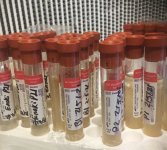shroombee said:Liquid culture is more prone to contamination. It works best for mass production when you need to inoculate a lot of grain. With agar you can see most contaminants so you can toss the agar before inoculating (and wasting) grain.
Shroombee! Where have you been all my life!? :lol:
And thank you. You helped me confirm my plan and course of action with my project.
Do you feel that contamination is still more likely if the liquid culture vessel lid has a self healing injection port and tyvek over the gas exchange hole?
One love

